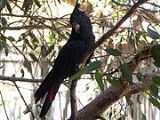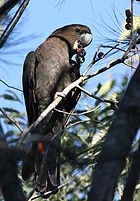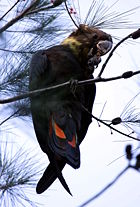
Glossy Black-Cockatoo
Encyclopedia
The Glossy Black Cockatoo (Calyptorhynchus lathami), also known as the Casuarina Black Cockatoo after one of their preferred food items, is the smallest member of the subfamily Calyptorhynchinae
found in Australia. Adult Glossy Black Cockatoos may reach 50 cm (20 in) in length. They are sexually dimorphic
. Males are completely black in colour, excepting their prominent red tail bands; the females are dark brownish with some yellow spotting. Three subspecies are recognised.
in 1807. The scientific name honours the English ornithologist John Latham
.
The Glossy Black Cockatoo's closest relative is the Red-tailed Black Cockatoo
; the two species form the subgenus Calyptorhynchus within the genus of the same name. They are distinguished from the other Black Cockatoos of the subgenus Zanda
by their significant sexual dimorphism
and calls of the juveniles; one a squeaking begging call, the other a vocalization when swallowing food.
et al. in 1993, although parrot expert Joseph Forshaw has reservations due to their extremely minimal differences.
. The male Glossy Black Cockatoo is predominantly black with a chocolate brown head and striking caudal red patches. The female is a duller dark brown, with flecks of yellow in the tail and collar. The female's tail is barred whereas the male's tail is patched. An adult will grow to be about 46–50 cm (18–20 in) in length. The birds are found in open forest and woodlands, and usually feed on seeds of the she-oak (Casuarina
spp.)

 Like most species of parrot
Like most species of parrot
s, the Glossy Black Cockatoo is protected by the Convention on International Trade in Endangered Species of Wild Fauna and Flora (CITES) with its placement on the Appendix II list of vulnerable species, which makes the import, export, and trade of listed wild-caught animals illegal.
Glossy Black-cockatoos generally are not listed as threatened on the Environment Protection and Biodiversity Conservation Act 1999
, however the Kangaroo Island race, C.lathami halmaturinis was added to the list as endangered.
.
Cockatoo
A cockatoo is any of the 21 species belonging to the bird family Cacatuidae. Along with the Psittacidae and the Strigopidae , they make up the parrot order Psittaciformes . Placement of the cockatoos as a separate family is fairly undisputed, although many aspects of the other living lineages of...
found in Australia. Adult Glossy Black Cockatoos may reach 50 cm (20 in) in length. They are sexually dimorphic
Sexual dimorphism
Sexual dimorphism is a phenotypic difference between males and females of the same species. Examples of such differences include differences in morphology, ornamentation, and behavior.-Examples:-Ornamentation / coloration:...
. Males are completely black in colour, excepting their prominent red tail bands; the females are dark brownish with some yellow spotting. Three subspecies are recognised.
Taxonomy
The Glossy Black Cockatoo was first described by Dutch naturalist Coenraad Jacob TemminckCoenraad Jacob Temminck
Coenraad Jacob Temminck was a Dutch aristocrat and zoologist.Temminck was the first director of the National Natural History Museum at Leiden from 1820 until his death. His Manuel d'ornithologie, ou Tableau systematique des oiseaux qui se trouvent en Europe was the standard work on European birds...
in 1807. The scientific name honours the English ornithologist John Latham
John Latham (ornithologist)
John Latham was an English physician, naturalist and author. He was born at Eltham in Kent, and was the eldest son of John Latham, a surgeon there, and his mother was a descendant of the Sothebys, in Yorkshire....
.
The Glossy Black Cockatoo's closest relative is the Red-tailed Black Cockatoo
Red-tailed Black Cockatoo
The Red-tailed Black Cockatoo , also known as Banksian- or Banks' Black Cockatoo, is a large cockatoo native to Australia. This species was known as Calyptorhynchus magnificus for many decades until the current scientific name was officially conserved in 1994. It is more common in the drier parts...
; the two species form the subgenus Calyptorhynchus within the genus of the same name. They are distinguished from the other Black Cockatoos of the subgenus Zanda
Zanda
Zanda may refer to:* a subgenus of three species of black cockatoo within the genus Calyptorhynchus* Zanda County, county in Tibet*Zanda, Tibet, seat of Zanda County*Zanda,...
by their significant sexual dimorphism
Sexual dimorphism
Sexual dimorphism is a phenotypic difference between males and females of the same species. Examples of such differences include differences in morphology, ornamentation, and behavior.-Examples:-Ornamentation / coloration:...
and calls of the juveniles; one a squeaking begging call, the other a vocalization when swallowing food.
Subspecies
The three subspecies were proposed by SchoddeRichard Schodde
Richard Schodde, OAM is an Australian botanist and ornithologist.Schodde studied at the University of Adelaide where he received a BSc in 1960 and a PhD in 1970. During the 1960s he was a botanist with the CSIRO Division of Land Research and Regional Survey in Papua New Guinea...
et al. in 1993, although parrot expert Joseph Forshaw has reservations due to their extremely minimal differences.
- C. l. lathami: (Rare) The eastern subspecies found between southeastern QueenslandQueenslandQueensland is a state of Australia, occupying the north-eastern section of the mainland continent. It is bordered by the Northern Territory, South Australia and New South Wales to the west, south-west and south respectively. To the east, Queensland is bordered by the Coral Sea and Pacific Ocean...
and MallacootaMallacoota, Victoria-External links:***...
in Victoria, with isolated pockets in EungellaEungella National ParkEungella is a national park in Queensland, Australia, 80 km west of Mackay, and 858 km northwest of Brisbane. The original inhabitants are the Goreng goreng people. The park is covered by dense rainforest and is known for its platypuses.The national park was established in 1941 and is...
in central Queensland and the RiverinaRiverinaThe Riverina is an agricultural region of south-western New South Wales , Australia. The Riverina is distinguished from other Australian regions by the combination of flat plains, warm to hot climate and an ample supply of water for irrigation. This combination has allowed the Riverina to develop...
and Pilliga forestPilliga forestThe State Forests of The Pilliga, commonly known as the Pilliga Scrub , constitute some 3000 km2 of semi-arid woodland in temperate north-central New South Wales, Australia...
. It is associated with casuarinaCasuarinaCasuarina is a genus of 17 species in the family Casuarinaceae, native to Australasia, southeast Asia, and islands of the western Pacific Ocean. It was once treated as the sole genus in the family, but has been split into three genera .They are evergreen shrubs and trees growing to 35 m tall...
woodland. - C. l. erebus Occurs in central Queensland.
- C. l. halmaturinus: (Endangered) The Kangaroo IslandKangaroo IslandKangaroo Island is Australia's third-largest island after Tasmania and Melville Island. It is southwest of Adelaide at the entrance of Gulf St Vincent. Its closest point to the mainland is off Cape Jervis, on the tip of the Fleurieu Peninsula in the state of South Australia. The island is long...
subspecies has been listed by the Australian Government as endangered. Restricted to the northern and western parts of the island, the population may be as low as 100 individuals. It depends on the Drooping She-oak (Allocasuarina verticillataAllocasuarina verticillataAllocasuarina verticillata or drooping sheoak is a nitrogen fixing native tree of southeastern Australia. Originally collected in Tasmania and described as Casuarina verticillata by French naturalist Jean-Baptiste Lamarck in 1786, it was moved to its current genus in 1982 by Australian botanist...
) and the Sugar Gum (Eucalyptus cladocalyxEucalyptus cladocalyxThe Sugar Gum is a eucalypt from South Australia. It is found naturally in three distinct populations - in the Flinders Ranges, Eyre Peninsula and on Kangaroo Island. Sugar Gums from the Flinders Ranges reach up to 35m in height and have the classic "gum" habit - with a straight trunk and steep...
) In particular, the bird specialises in the most recent season's cones of Allocasuarina verticillata over older cones of that species and Allocasuarina littoralisAllocasuarina littoralisAllocasuarina littoralis or Black Sheoak is an endemic medium-sized Australian tree . A...
. It holds the cones in its foot and shreds them with its powerful bill before removing the seeds with its tongue.
Description
Like the related Red-tailed Black Cockatoo, this species is sexually dimorphicSexual dimorphism
Sexual dimorphism is a phenotypic difference between males and females of the same species. Examples of such differences include differences in morphology, ornamentation, and behavior.-Examples:-Ornamentation / coloration:...
. The male Glossy Black Cockatoo is predominantly black with a chocolate brown head and striking caudal red patches. The female is a duller dark brown, with flecks of yellow in the tail and collar. The female's tail is barred whereas the male's tail is patched. An adult will grow to be about 46–50 cm (18–20 in) in length. The birds are found in open forest and woodlands, and usually feed on seeds of the she-oak (Casuarina
Casuarina
Casuarina is a genus of 17 species in the family Casuarinaceae, native to Australasia, southeast Asia, and islands of the western Pacific Ocean. It was once treated as the sole genus in the family, but has been split into three genera .They are evergreen shrubs and trees growing to 35 m tall...
spp.)
Conservation Status


Parrot
Parrots, also known as psittacines , are birds of the roughly 372 species in 86 genera that make up the order Psittaciformes, found in most tropical and subtropical regions. The order is subdivided into three families: the Psittacidae , the Cacatuidae and the Strigopidae...
s, the Glossy Black Cockatoo is protected by the Convention on International Trade in Endangered Species of Wild Fauna and Flora (CITES) with its placement on the Appendix II list of vulnerable species, which makes the import, export, and trade of listed wild-caught animals illegal.
Glossy Black-cockatoos generally are not listed as threatened on the Environment Protection and Biodiversity Conservation Act 1999
Environment Protection and Biodiversity Conservation Act 1999
The Environment Protection and Biodiversity Conservation Act 1999 is an Act of the Parliament of Australia that provides a framework for protection of the Australian environment, including its biodiversity and its natural and culturally significant places...
, however the Kangaroo Island race, C.lathami halmaturinis was added to the list as endangered.
State of Victoria, Australia
- The eastern subspecies of the Glossy Black-cockatoo (C. l. lathami) is listed as threatened on the Victorian Flora and Fauna Guarantee Act (1988). Under this Act, an Action Statement for the recovery and future management of this species has not been prepared.
- On the 2007 advisory list of threatened vertebrate fauna in Victoria, the subspecies C. l. lathami is listed as vulnerableVulnerable speciesOn 30 January 2010, the IUCN Red List of Threatened Species identified 9694 Vulnerable species, subspecies and varieties, stocks and sub-populations.-References:...
.
State of Queensland, Australia
C. lathami lathami is listed as vulnerable by the Environmental Protection Agency (Queensland)Environmental Protection Agency (Queensland)
Queensland's Environmental Protection Agency was for some time a separate department of the Queensland Government, and, following 2009 State elections, became a part of the Government's larger Department of Environment and Resource Management.This part of the Department of Environment and...
.
Cited texts
- Flegg, Jim. Birds of Australia: Photographic Field Guide Sydney: Reed New Holland, 2002. (ISBN 1-876334-78-9)
- Garnett, S. (1993) Threatened and Extinct Birds Of Australia. RAOU. National Library, Canberra. ISSN 0812-8014
External links
- World Parrot Trust Parrot Encyclopedia - Species Profiles
- Threatened species and ecological communities
- GlossyBlackCockatoo.com

